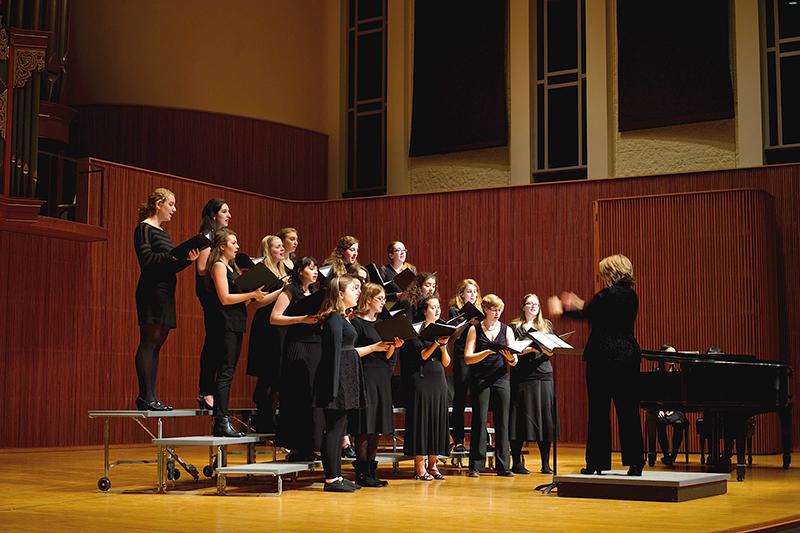Choir Struggles with Timbre, Delivers Spirited Concert
The Oberlin Women’s Chorale sings in Warner Concert Hall on Wednesday. The all-female vocal group gave a spirited performance of both contemporary and traditional pieces.
December 5, 2014
At its best, a choir sounds like a single homogenous instrument as opposed to many distinct voices. The Oberlin Women’s Chorale only occasionally achieved that level of cohesion during its concert on Wednesday night in Warner Concert Hall. Though the chorus sang competently, its sound was occasionally hesitant, and after a time, the musical selections became repetitive.
The concert began with Conservatory sophomore Chuyi Liu coaxing soft tones from the piano to set the melancholy mood. The choir then performed Joseph Martin’s hauntingly beautiful “The Awakening.” When Martin’s music branched off into several different, overlapping melodies, the students carefully interwove their voices to blend the contrapuntal lines. A round in the middle of the piece sounded at first like the chiming of bells as each toll echoed among the voices, but as more and more singers entered, the sound became muddled. However, all of the singers soon rallied, and their collective timbre grew stronger than before, ending the song on a hopeful note.
Before they sang “Things That Never Die” by Lee Dengler, the conductor, Director of Music Education Jody Kerchner, introduced the piece by saying that it “speaks to issues that never die.”
She explained that she felt it was particularly timely, given all of the current problems in the world, particularly the recent issues pertaining to race. The song was short and sweet. The several rounds incorporated in the piece were much clearer, creating an echoing sound.
Kerchner introduced “Ave regina caelorum” by Chiara Cozzolani with a description of the composer. She explained that Cozzolani was a nun who lived not in a convent but in “a house with nuns.” The inhabitants were renowned for their musical talent at a time when it was unusual for women to be composers. The pre-baroque song was only recently arranged for a women’s choir. The text was in Latin, so most listeners were left to focus on the sounds themselves. The whispering quality of the ‘s’ sound contrasted with the more full and open vowels.
By the time the chorale sang “Measure Me, Sky” by James Mullholland, the songs had begun to blur. All of the pieces had the same high-pitched, melancholy sound, with only slight variations on the theme to differentiate them. The words were often muffled behind the instrumentals, so the emphasis mainly fell on the rise and fall of the singers’ combined voices. The song came to a full stop several times, breaking it up into sections. Their voices rose to a powerful finale, though the high register of their voices was shrill to the ear.
Gwyneth Walker’s “Now I Become Myself ” added some muchneeded variation to the program with a few distinct touches. The piece began with a powerful sound on the piano, contrasting the sharper, high-pitched voices of the singers. The singing was also accompanied by vocalizations and the low chanting of what formed the chorus of the song: “Now I become myself, myself,” repeated in short succession. When the singers first branched off into several different, simultaneous melodies, it became muddled so that the parts were not distinguishable from one another. When the melodies separated again, however, the overlapping strands brought power and urgency to the piece without losing clarity. The song ended with everyone impressively sustaining a single note.
For “Look to the Rainbow” from Finian’s Rainbow, composed by Burton Lane, one of the students in the chorale stepped up to the conductor’s stand. The song had a similar sound to those that preceded it, but since the performers sang in near-perfect tandem, the words were clearer. The song told the story of a family’s legacy and hopes for a child who is told to “follow the fellow who follows a dream.”
Jody Kerchner returned to conduct the final piece of the evening: “Clap Yo’ Hands” by George and Ira Gershwin. Several of the singers put down their songbooks before it to clap along with the music, making for a fun and spirited finale.

















